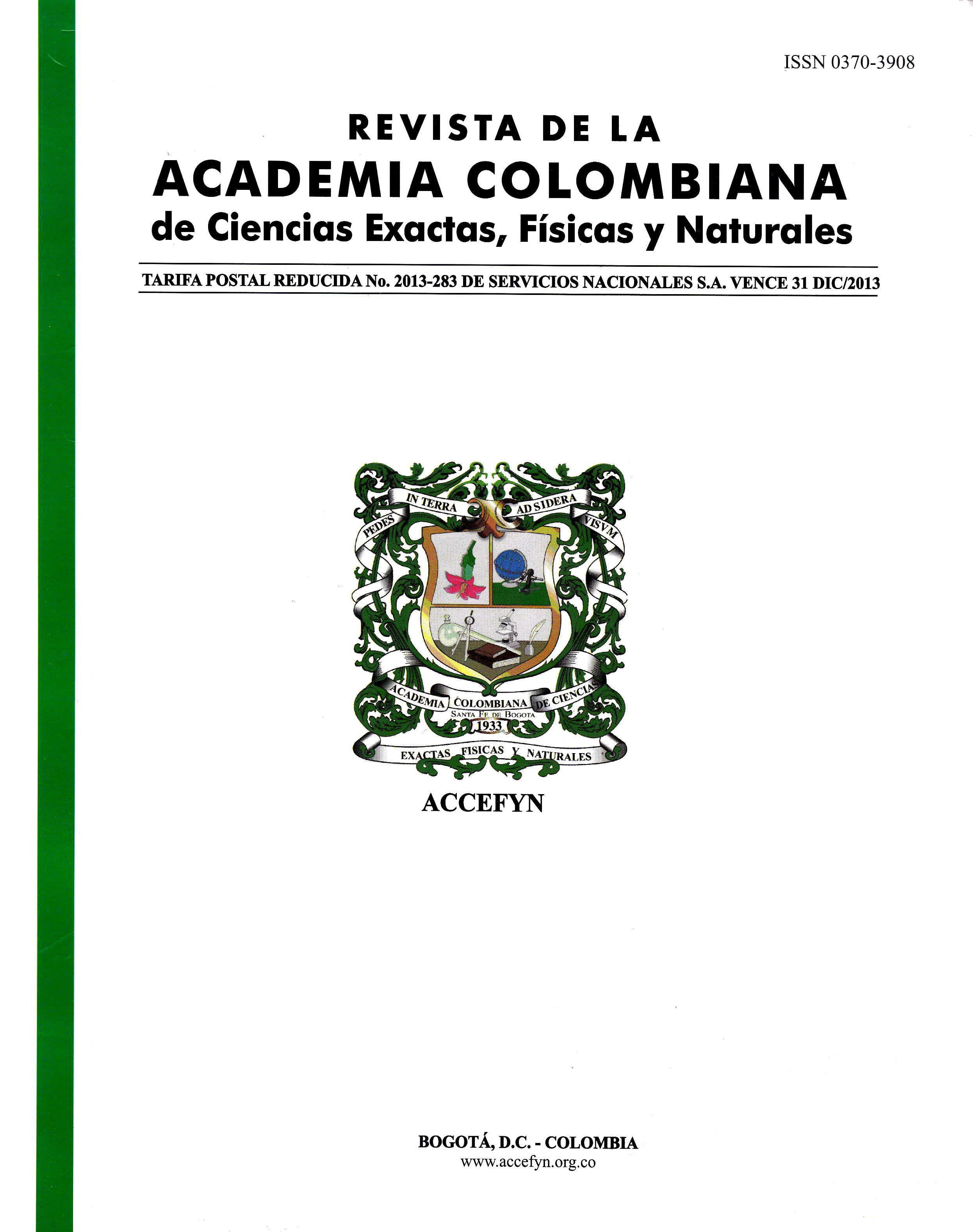Resumen
En este artículo se describen, de manera resumida, algunos trabajos realizados en el laboratorio de polímeros de la Universidad del Valle sobre ácido polil-L-láctico (PLLA), un compuesto biodegradable. Específicamente se describe la síntesis de PLLA de alto y bajo peso molecular y su aplicación en la fabricación de dispositivos o de andamios (scaffolds) para el crecimiento de células óseas, ya sea en forma de bloques blandos, películas, bloques porosos y tornillos. La caracterización de los diferentes materiales se realizó por espectroscopia (resonancia magnética, RMN, e infrarrojo, IR), análisis térmico, y microscopía, por determinación de sus pesos moleculares (viscosimetría, cromatografía) y de sus propiedades mecánicas. Los implantes, las pruebas de biocompatibilidad y de crecimiento celular se realizaron en conejos y se evaluaron de forma macroscópica, y mediante pruebas histológicas.
Referencias
ACHMAD, F., YAMANE, K., QUAN, S., KOKUGAN, T. 2009. Synthesis of polylactic acid by direct polycondensation under vacuum without catalysts, solvents and initiators, Chemical Engineering Journal, 151, (1-3), 15, 342-350
ALCALDE, J.C. 2005. Trabajo de Grado, Escuela de Ingeniería de Materiales, Director: Fabio Zuluaga, Universidad del Valle, Cali.
BATCHELOR, ANDREW W. 2004. Service Characteristics of Biomedical Materials and Implants, Series on Biomaterials and Bioengineering, Volume 3, Singapore: Imperial College Press, 183.
BETANCOURT, J., 2012. Informe Joven Investigador, Director: Fabio Zuluaga, Universidad del Valle-Colciencias. CABARET O, MARTIN-VACAB, BOURISSOU D. 2004. Controlled ring-opening polymerization of lactide and glycolide, Chem. Rev.;104 (12): 6147-6176.
CHU, C. 1981. Hydrolytic degradation of poly (glycolic acid): tensile strength and crystallinity study, Journal of Applied Polymer. Science. 26. 1727-1734.
CORREA, J.P., BETANCOURT, J., 2010. Trabajo de Grado, Escuela de Ingeniería de Materiales, Director: Fabio Zuluaga, Universidad del Valle, Cali.
CORREA, L.S., GODOY, J., 2011. Trabajo de Grado, Escuela de Ingeniería de Materiales, Director: Fabio Zuluaga, Universidad del Valle, Cali. DARENSBOURG, D. J., KARROONNIRUN, O. 2010. Ring-Opening Polymerization of L-Lactide and ε-Caprolactone Utilizing Biocompatible Zinc Catalysts. Random Copolymerization of L-Lactide and ε-Caprolactone, Macromolecules, 43: 8880–8886.
ESPARTERO J.L., RASHKOV I., LI S., MANOLOVA N., VERT, M. 1996. Macromolecules, 29: 3535-3539.
GARLOTTA, D. 2001.A Literature Review of Poly(Lactic Acid), Journal of Polymers and The Environment, 9, (2), 63-84.
GONZALEZ, D. 2009. Trabajo de Grado, Programa Académico de Química, Director: Fabio Zuluaga, Universidad del Valle, Cali.
GROOVER M. 2007. Fundamentos De Manufactura Moderna: Materiales Procesos Y Sistemas, 3a Ed. Mexico:Mcgraw-Hill,Cap 13.
HYON S, JAMSHID K, IKADA Y. 1997. Synthesis of polylactides with different molecular weights, Biomaterials.; 18 (22): 1503-1508.
KIESEWETTER, M. K., SHIN, E. J., HEDRICK, J. L., WAYMOUTH, R. M., 2010. Organocatalysis: Opportunities and Challenges for Polymer Synthesis, Macromolecules, 43: 2093-2107.
KNIGHT, R. I.; WILCOX, H. E.; KOROSSIS, S. A.; FISHER, J.; INGHAM, E. 2008. The use of acellular matrices for the tissue engineering of cardiac valves. Journal of Engineering in Medicin, 222(H1), 129-143.
LANZA, H. 2007. Principles of tissue Engineering. Elsevier.
LUNT, J. 1998. Large scale production, properties and commercial applications of polylactic polymers, Polymer Degradation and stability, 59, 145.
LUTEN, J., VAN NOSTRUM, C.F., DE SMEDT, S.T., HENNINK, W.E.. 2008. Biodegradable polymers as non-viral carriers for plas-2008. Biodegradable polymers as non-viral carriers for plasmid DNA delivery, Journal of. Controlled Release 126(2), 97-110.
MAGON, A., PYDA M. 2009. Study of crystalline and amorphous phases of biodegradable poly(lactic acid) by advanced thermal analysis, Polymer.; 50 (16): 3967–3973.
MITRAGOTRI SAMIR , LAHANN JOERG. 2009. Physical approaches to biomaterial design. Nature Materials 8, 15-23.
MOTTA A, DUEK E. 2006. Synthesis, characterization and “in vitro” Degradation of PLLA, Polímeros: Ciência e Tecnologia.; 16 (1): 26-32; MUELLER, R. J. 2006. Biological degradation of synthetic polyesters–enzymes as potential catalysts for polyester recycling, Proceedings of. Biochemistry., , 43: 2124-2128
NAMPOOTHIRI, K.M., NAIR, N.R., JHON, R.P. 2010. An overview of the recent developments in polylactide research, Bioresearch Technology 101,8493-8501.
NIJENKUIS AJ, GRIJPME DW, PENNINGS AJ. 1992. Lewis acid catalyzed polymerization of L-lactide. Kinetics and mechanism of the bulk polymerization, Macromolecules, 25:6419–6424.
PEREGO G, CELLA G, BASTIOLI C. J. 1996. Effect of molecular weight and crystallinity on poly(lactic acid) mechanical properties, Journal of Applied Polymer. Science, 59 (1), 37-43.
PROIKAKIS, C.S, TARANTILI, P.A, ANDREOPOULOS, A.G. 2002. Synthesis and Characterization of Low Molecular Weight Polylactic Acid, Journal of Elastomers & Plastics, 34, 49-63.
RASAL, R. M., JANORKAR, A. V., HIRT, D. E. 2010. Poly (lactic acid) modifications, Progress in Polymers Science, 35: 338-356.
RYTTIN, E., NGUYEN, J., WANG, X., KISSEL, T. 2008. Biodegradable polymeric nanocarriers for pulmonary drug delivery, , Expert Opinion on Drug Delivery, 5(6), 629-639.)
SAVIOLI LOPEZ, M., JARDINI, A. L. 2012. MACIEL FLHO, R., Polylactic acid production for tissue engineering applications, Procedia Engineering, 42, 1402-1413.
SHIMAO, M. 2001. Biodegradation of Plastics, Current opinion Biotechnology, 12, 242-247
SHYAMROY, S. 2003. Synthesis of Biodegradable Poly (Lactic Acid) Polymers, Ph.D. Thesis, Poona (India): University of Poona.
SOARES, J.S., MOORE, J.E., RAJAGOPAL, K.R. 2008. Constitutive Framework for biodegradable polymers with applications to biodegradable stents, ASAIO Journal, 54(3), 295-301.
SOLIS, Y., BETANCUR, C., 2007. Trabajo de Grado, Escuela de Ingeniería de Materiales, Director: Fabio Zuluaga, Universidad del Valle, Cali.
STARK, W.J., SCHNEIDER, O., LOHER, S.F., BRUNER, T., SIMONET, M., SCHMIDLIN, P., GRASS, R.N. 2008. Implant materials comprising biodegradable polymers and inorganic particles, Canadian Patent International Application STAÜDINGER, H., FRITSCHI, J. 1922. Helvetica Chimica Acta, 5, 785-806.
ULERY, B. D., NAIR, L. S., LAURENCIN, C. T. 2011. Biomedical Ap-Biomedical Applications of Biodegradable Polymers, Journal Of Polymer Science Part B: Polymer Physics, 49.832–864.
VAZQUEZ, J.D., 2010 Trabajo de Grado, Escuela de Ingeniería de Materiales, Director: Fabio Zuluaga, Universidad del Valle, Cali.
WANG X, LIAO K, QUAN D, WU Q. 2005. Macromolecules.; 38: 4611-4617.
WANG, Y., ZERN, B., GUMERA. 2008. Biomimetic Polymers for Tissue Engineering,, C., Canadian Patent International Application
WILFRIED HAENSEL. 2011. Annual Report, Plastics Europe Association.

Esta obra está bajo una licencia internacional Creative Commons Atribución-NoComercial-SinDerivadas 4.0.
Derechos de autor 2023 Revista de la Academia Colombiana de Ciencias Exactas, Físicas y Naturales

